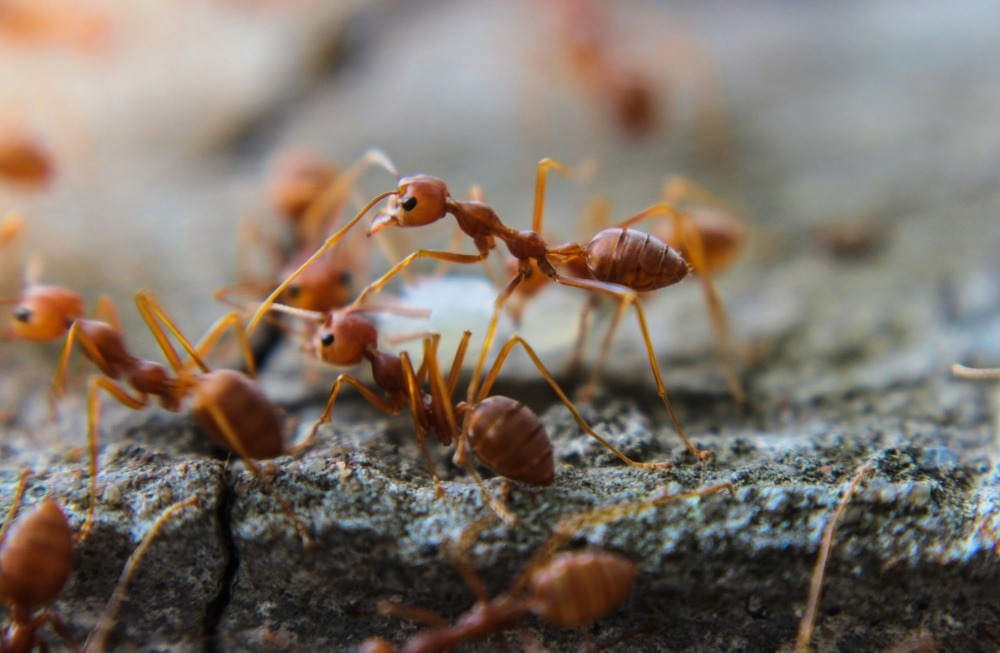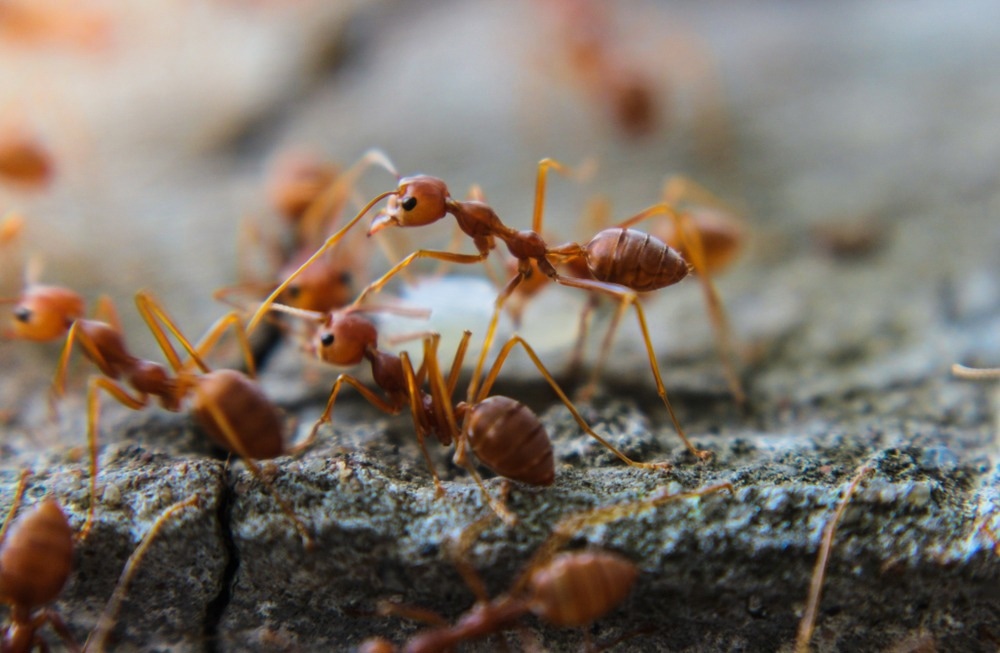In a recent study published in Proceedings of the Royal Society, researchers demonstrated the use of ants as olfactory bio-detectors of human tumors.

Background
Immunology eBook

Better diagnostic methods for cancer, a leading cause of mortality globally, could help increase patient survival rates. Currently used methods for cancer detection are either invasive (e.g., coloscopy) or expensive (e.g., magnetic resonance imaging). Animals could detect volatile organic compounds (VOCs) in human tumors and help increase early cancer detection rates.
Previous studies have shown the use of dogs to detect tumors in body-odor samples. Caenorhabditis elegans, a nematode show chemotaxis to some cancer VOCs. A recent work deploying in vivo calcium imaging based on the proboscis extension response showed that honey bees and dogs could not detect a cancer odor despite olfactory conditioning.
Thus, researchers have begun to think of alternatives and found insects as promising bio-detectors of different types of odor. They are available in huge numbers, relatively easy to manage, and do not require expensive rearing facilities.
Among insects, ants, due to their refined sense of olfaction, could be quickly trained with olfactory conditioning. Formica fusca demonstrated extraordinary learning potential using ecologically relevant odors. In this species, one training trial was enough to form a long-term memory lasting several days. However, most importantly, they tested nine times after training without reward before their responses started to diminish.
About the study
In the present study, researchers used urine samples from patient-derived xenograft (PDX) mice carrying ‘triple-negative’ human breast tumors as olfactory stimuli to train ant workers of the F. fusca species. They conditioned half of the ants, i.e., 35 ants, with the urine of tumor-bearing and the other half with healthy, sham-treated mice (control).
During the acquisition phase, these ants learned the two different olfactory stimuli to the same extent; however, the time spent to find the reward decreased gradually across the three training trials. Notably, for training trials, the team used flower or fruit-derived pure compounds or odor blends, all ecologically relevant for ants.
First, the researchers analyzed the VOC composition of urine odor samples using solid-phase micro-extraction (SPME) and gas chromatography in combination with mass spectrometry (GC-MS). This simple conditioning paradigm helped the researchers find cues used by ants to distinguish the tumor mice from the control mice.
The researchers also performed a chemical analysis of the VOCs emitted by the urine of both groups. Tumor size determined the chemical similarity/dissimilarity between the odor samples. Hence, the larger the tumor of a PDX mouse, the more chemically dissimilar it became from a sham group of mice.
During behavior tests, the researchers randomly assigned an ant to the odor of three different mice for conditioning. However, during the memory tests, they used six different mice from other groups. Thus, ants did not depend on a single odor of a given mouse. According to the authors, using only small tumors to test ants' olfactory capabilities could help find their detection threshold.
Finally, the researchers separately analyzed the results of the tests involving small and large tumors, and they also performed post hoc tests.
Study findings
The study showed that ants learned to associate a complex blend of odors with a reward after only three conditioning trials. Even during unrewarded tests, F. fusca ants distinguished tumor-bearing PDX mice from tumor-free PDX mice. Also, ants detected VOCs at low concentrations.
Though cancer cells are not ecologically relevant for ants, like many other animals, ants have learned to detect other olfactory stimuli, given the right incentive. However, PDX mice presented a more complex task because they had heterogeneous tumors. The odor was not cancer cell-originated and mixed with body odors or odors from the local microenvironment (e.g., exhaled breath or sweat). Yet, ants reliably discriminated sham group urine samples from tumor group samples, independent of the odor used during conditioning.
Of the 210 tests performed on 70 ants (three tests on each ant), 74 tests involved the most minor tumors, ranging in size between 196mm3 to 405mm3, and 136 tests involved the largest tumors. The researchers found that the responses of ants were comparable between the two groups, with no significant olfactory stimulus size interaction.
Conclusions
In this first-of-its-kind proof-of-concept study, the researchers remarkably demonstrated that ants could detect cancer in a whole organism. In this study, they used a total of 70 ants. However, 35 ants were more than enough to uncover a significant difference between the tumor and tumor-free samples. Based on the final study results, 24 ants would have served the cause.
On average, researchers spent ~10 minutes conditioning a single ant. They performed memory tests after 15 minutes of completing the conditioning test, and it fetched the first discriminating results in ~37 minutes. Considering they worked with 24 ants, the researchers would have needed ~15 hours to condition and test these ants in a real-life cancer screening situation.
Since these ants were resistant to memory extinction, a single conditioning trial updated with a reward trial could reduce the conditioning time between two patients by more than 15 hours. Furthermore, ants could easily perform more than three tests before they needed a memory update. In this regard, a better understanding of how ants share information among nest-mates could also help find a much quicker conditioning method, given they share cancer-related odors within their colony.
The study method needs further validation using different types of tumors of human origin before being considered a routine cancer screening test. Nevertheless, ants could prove to be inexpensive and efficient non-invasive tools for early human tumor diagnoses.
- Piqueret Baptiste, Montaudon Élodie, Devienne Paul, Leroy Chloé, Marangoni Elisabetta, Sandoz Jean-Christophe, d'Ettorre Patrizia, Ants act as olfactory bio-detectors of tumours in patient-derived xenograft mice, Proc. R. Soc. B. 2023, doi: http://doi.org/10.1098/rspb.2022.1962
https://royalsocietypublishing.org/doi/10.1098/rspb.2022.1962
Posted in: Medical Science News | Medical Research News | Disease/Infection News
Tags: Caenorhabditis elegans, Calcium, Cancer, Cell, Chemical Analysis, Chromatography, Diagnostic, Fruit, Gas Chromatography, Honey, Imaging, in vivo, Magnetic Resonance Imaging, Mass Spectrometry, micro, Mortality, Olfaction, Spectrometry, Tumor, Xenograft

Written by
Neha Mathur
Neha is a digital marketing professional based in Gurugram, India. She has a Master’s degree from the University of Rajasthan with a specialization in Biotechnology in 2008. She has experience in pre-clinical research as part of her research project in The Department of Toxicology at the prestigious Central Drug Research Institute (CDRI), Lucknow, India. She also holds a certification in C++ programming.
Source: Read Full Article
